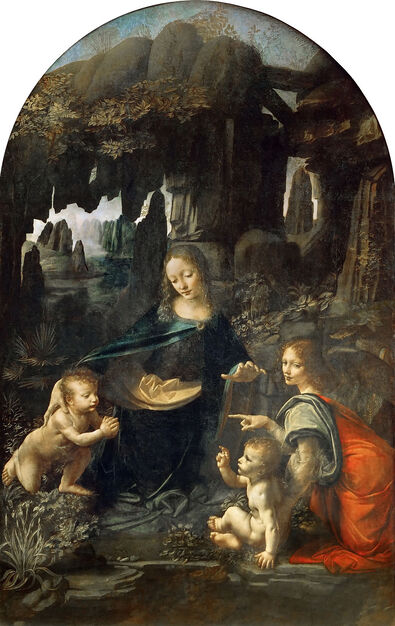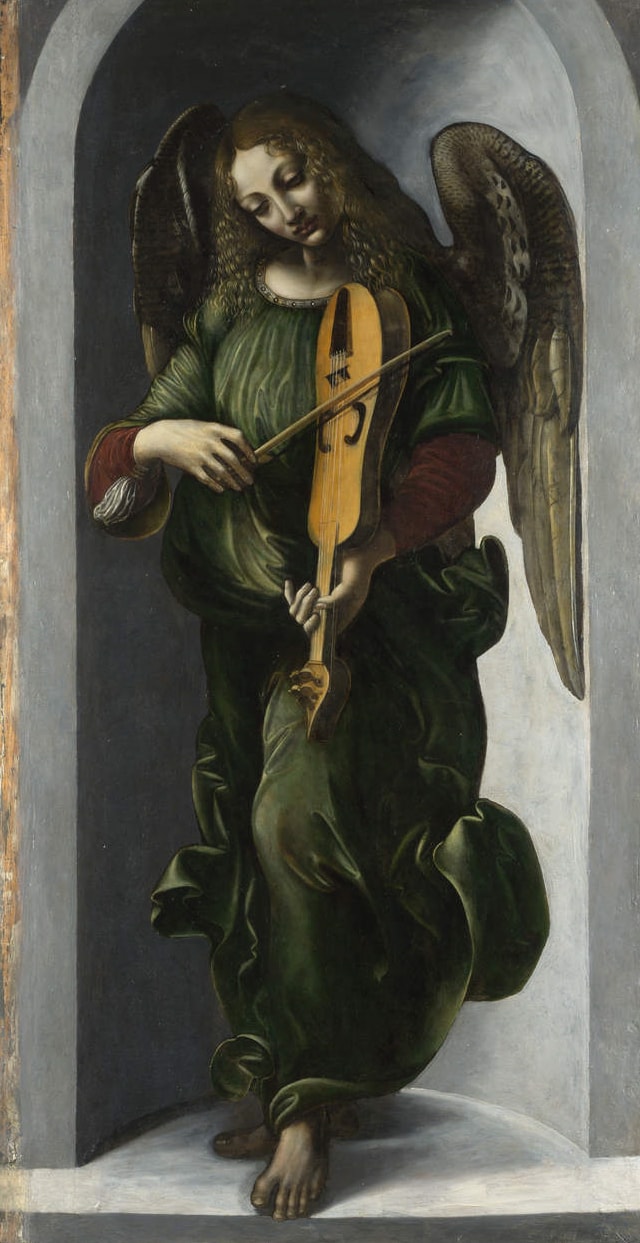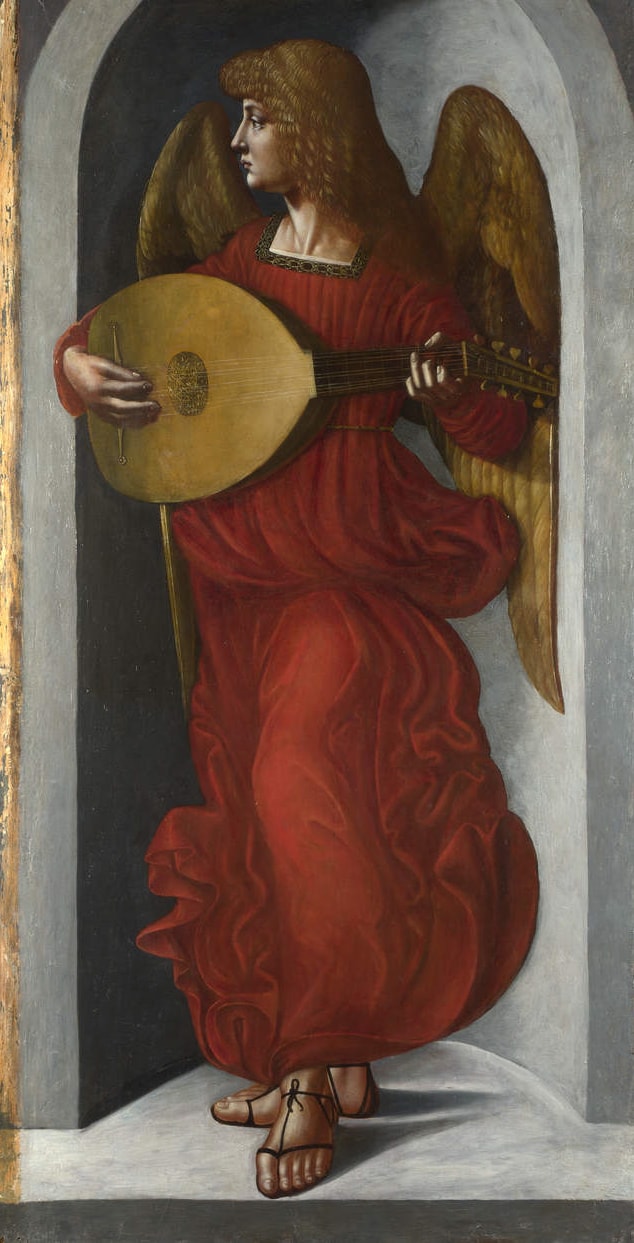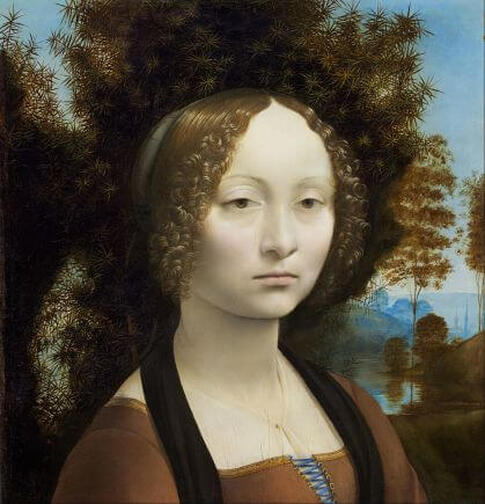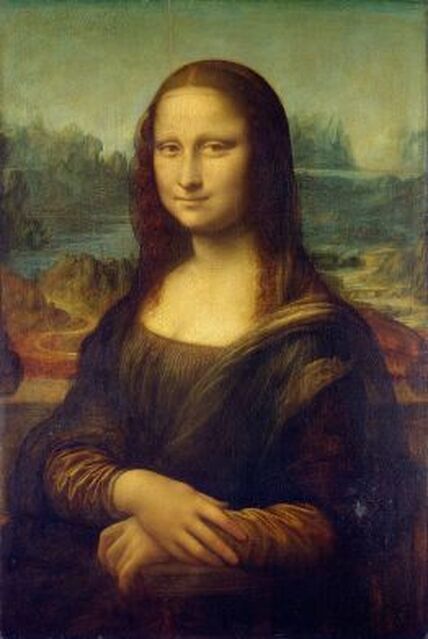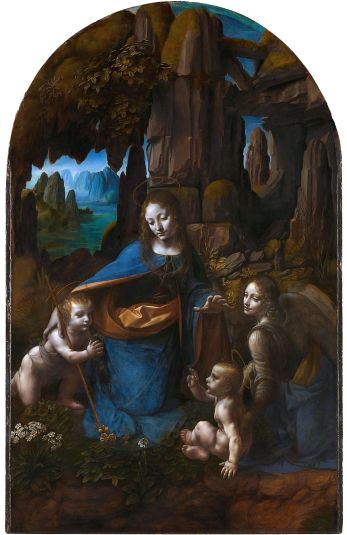|
Where? First floor, room 710 of the Denon wing in the Louvre
When? 1483-1486 Commissioned by? Prior Bartolomeo Scorlione and the Confraternity for the Chapel of the Confraternity of the Immaculate Conception in the church of San Francesco Maggiore in Milan. What do you see? The Virgin Mary, the children Jesus and John the Baptist, and an angel are pictured in a triangular composition in a rocky environment. The Virgin Mary sits on the ground, which is referred to as the Madonna of Humility. She is the center of attention in this painting. The right hand of Mary is on the shoulder of John the Baptist (who is the child on the left). The left hand of Mary is right above the head of Jesus, which can be interpreted as a protective gesture. John the Baptist is folding his hands and is praying towards Jesus. At the same time, Jesus, who is directly to the left of the angel, is raising his right hand to bless John the Baptist. The angel most likely represents the Archangel Gabriel, even though the angel looks quite feminine (the painting of androgynous figures was a trademark of Leonardo da Vinci). The angel is pointing towards John the Baptist. In the background you can see the rocky grotto and a river, most likely inspired by the Dolomite Mountains, which are to the northeast of Milan. In the foreground and in the grotto various flowers and plants are depicted (including irises, lilies, and ivy). The painting has been finished using the sfumato technique, the smoky/hazy effects, which creates a somewhat magical atmosphere. Backstory: The commissioner of this painting wanted Leonardo da Vinci to paint the Immaculate Conception (a Catholic dogma that Mary was born without sin) to serve as the center of an altarpiece for the Chapel of the Immaculate Conception. This chapel is part of the Saint Francesco Grande church in Milan, and the chapel was founded before 1335 by Beatrice d’Este, who was the wife of Galleazzo I, the Duke of Milan. On the left and right of this painting would be two paintings of angels playing a musical instrument to complete the altarpiece. On the left is An Angel in Green with a Vielle painted by an associate of Leonardo, possibly Francesco Napoletano. On the right is An Angel in Red with a Lute by Giovanni Ambrogio de Predis. The Virgin of the Rocks in the Louvre is thought to be painted entirely by Leonardo da Vinci, which is not always the case for paintings of Leonardo.
Symbolism: This work contains several symbolic references:
This painting is also one of the first known paintings in which the halos are left out. The halos were used in the Middle Ages to indicate that somebody was holy or sacred but were in contrast to the realistic painting style of the Renaissance. What is sfumato? Sfumato comes from the Italian sfumare, which means ‘to evaporate like smoke’ and Leonardo da Vinci famously used the sfumato technique to create the atmosphere in his paintings. Leonardo applied the sfumato technique when the painting was almost finished by applying a coat of a mix of varnish and black pigment to create a hazy/smoky effect. Who is Leonardo da Vinci? Leonardo da Vinci (1452-1519) was born in the Italian village of Anchiano, which was very close to Vinci, which is where he got his name from. He was an architect, astronomer, engineer, inventor, mathematician, musician, painter, writer, and more. Leonardo da Vinci is known to be one of the biggest multi-talented people that the world has ever seen. Leonardo was notorious for being substantially late in delivering his paintings and was not afraid to abandon projects halfway. Leonardo has created a few famous portraits, including Ginevra de' Benci in the National Gallery of Art and the Mona Lisa in the Louvre.
Fun fact: Interestingly, there are two versions of this famous painting. The other version of The Virgin of the Rocks is in the National Gallery in London. The version in the Louvre was the first to be completed and is much less conventional.
For example, the version in the National Gallery contains halos on top of the heads of John the Baptist, Jesus, and Mary, and John the Baptist is carrying a cross with him (these elements are not present in the version in the Louvre). You can also see a clear difference in the face of Jesus. Also, in the National Gallery version of the painting, the angel is not pointing at John the Baptist and seems to gaze into the distance (as if the angel is dreaming/imagining this scene, instead of participating in it). The reason that there are two versions of this painting is that the Confraternity rejected the first version of Leonardo. It was not traditional enough (for example, no halos and a lack of symbolism) and thus did not suit the purpose of representing the dogma of the Immaculate Conception (which was the sole purpose of the Confraternity). Leonardo da Vinci considered the Louvre version of the painting a real masterpiece in which he could perfectly express his artistic ideas. After the Louvre-version of the painting was rejected, Leonardo created another version of this painting (the version in the National Gallery in London), which included all elements that the Confraternity asked for. Interested in a Copy for Yourself? Poster or canvas.
19 Comments
|
Categories
All
|
- Home
- Blog
-
Museums
- Alte Pinakothek
- Art Institute of Chicago
- Baltimore Museum of Art
- Barber Institute of Fine Arts
- Bargello
- Barnes Foundation
- British Museum
- Church of Sant’Anastasia
- Cleveland Museum of Art
- Courtauld Institute of Art
- Detroit Institute of Arts
- Frans Hals Museum
- Galleria Borghese
- Gallerie dell'Accademia
- Getty Museum
- Guggenheim
- Hermitage Museum
- Kunsthistorisches Museum
- Kunstmuseum Basel
- Legion of Honor Museum
- Louvre
- Mauritshuis
- Metropolitan Museum of Art
- Musee d’Orsay
- Museum of Fine Arts in Boston
- Museum of Modern Art
- National Gallery in London
- National Gallery of Art
- National Museum in Poznań
- Norton Simon Museum
- Ny Carlsberg Glyptotek
- Palace of Versailles
- Palazzo Pitti
- Palazzo Vecchio
- Petit Palais
- Philadelphia Museum of Art
- Prado
- Pushkin Museum
- Ravenna Art Museum
- Rijksmuseum
- San Diego Museum of Art
- Santa Maria delle Grazie
- St. Peter's Basilica
- Städel Museum
- Statens Museum for Kunst
- Tate Britain
- Tate Modern
- Timken Museum of Art
- Uffizi
- Vatican Museums
- Wallace Collection
-
Artists
- Altdorfer
- Anguissola
- Berlin Painter
- Bosch
- Botticelli
- Boucher
- Bronzino
- Bruegel the Elder
- Brunelleschi
- Cabanel
- Caillebotte
- Canova
- Caravaggio
- Carpeaux
- Cezanne
- Cimabue
- David
- Degas
- Delacroix
- De Maria
- Donatello
- El Greco
- Fontana
- Fra Angelico
- Fragonard
- Gauguin
- Gentileschi
- Gericault
- Gonzalez-Torres
- Goya
- Hals
- Hogarth
- Hokusai
- Ingres
- Leonardo da Vinci
- Lippi, Filippo
- Longhi, Barbara
- Lorrain
- Makovsky
- Manet
- Massys
- Matisse
- Merian
- Michelangelo
- Mochi
- Modigliani
- Monet
- Panini
- Parmigianino
- Perugino
- Picasso
- Pisanello
- Raphael
- Rembrandt
- Renoir
- Reynolds
- Rivera
- Rodin
- Rubens
- Scultori
- Seurat
- Steen
- Tintoretto
- Titian
- Toulouse-Lautrec
- Turner
- Uccello
- Van der Weyden
- Van Dyck
- Van Eyck
- Van Gogh
- Van Hemessen
- Vasari
- Velazquez
- Vermeer
- Veronese
- Vigée Le Brun
-
Locations
- Books
- About Us

